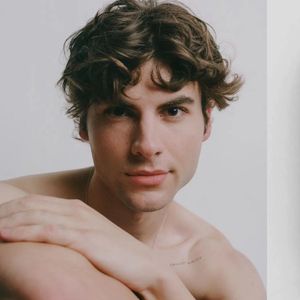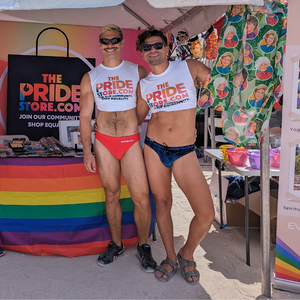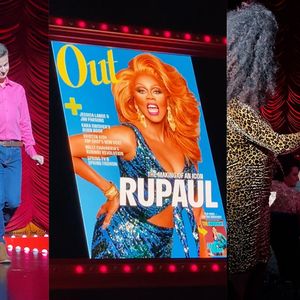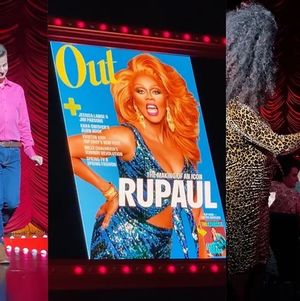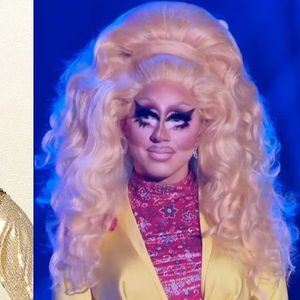All Rights reserved
By continuing to use our site, you agree to our Private Policy and Terms of Use.
Chicago's Lake View. Known to many as "Wrigleyville," the north side neighborhood serves as Chicago's sports mecca, where the Cubs play hardball in the Friendly Confines. And it's known to many more as "Boystown" because it serves as the city's vibrant gay center. Sure, the population of women is on the rise here, but still, in Lake View on a muggy spring eve the troposphere is saturated with testosterone emissions.
Can't you smell that smell?
"I'm sort of like in heat," says an animated Brian-Mark Conover, 49. The Chicago events organizer is at the Cell Block leather bar preparing for some 10,000 men from around the world to arrive for International Mr. Leather 2005 Memorial Day weekend.
To pick up the scent of man on this evening, follow any number of trails--to the dark bar in Cell Block on Halsted, to the cavernous Circuit nightclub, to the beer-soaked right-field bleachers in Wrigley Field. There's the gym, the bathhouse, the police precinct, the batting cages. So many trails for so many hound dogs.
According to new research from home and abroad, these scent trails may tell us something about the sexual orientation of the odor-seeker and perhaps the sexual orientation of the odor-maker.
In May researchers at the Karolinska Institute in Stockholm announced that gay men and straight women respond similarly to hormonal sex scents, and differently than straight men do. As for lesbians--well, it's complicated and inconclusive.
Using brain imaging, the scientists studied responses to a testosterone derivative in men's sweat, called AND, and an estrogen-related compound in women's urine, called EST. They found that sniffs of EST activated the ordinary olfactory region in straight women and gay men but fired up the hypothalamus, a region of the brain connected to sexual behavior, in straight men. Meanwhile, AND activated straight men's olfactory while firing up the hypothalamus in straight women and gay men.
The headlines to reports on the Stockholm study provided days of watercooler chatter and sent more than a few gay men out on the town minus even a splash of cologne or a swash of deodorant.
"There is something about the smell of a man, with maybe just an itty-bitty drop of Old Spice behind the ear," declares gay Chicagoan Rick Garcia, who says he abandoned cologne and deodorant years ago. "So that study makes perfect sense to me."
The power of certain smells is undeniable, adds native Brazilian Pedro Andrade, cover boy for this magazine. "I've always said that nothing brings me back to a place like scent," says Andrade, who now lives in New York. "No letter, no music, can remind you of things like smell. It's one of the most personal senses."
Also in May researchers at the Monell Chemical Senses Center in Philadelphia announced findings in a study on underarm odor and sexual orientation. Researchers asked 82 men and women to indicate their preference among 24 samples of sweat from men and women, gay and straight. They found that gay men preferred the sweat of other gay men but their sweat was least preferred by heterosexual men, heterosexual women, and lesbians.
"The bottom line is that the production and perception of body odor is influenced by gender and sexual orientation," says Monell neuroscientist Charles Wysocki, who has studied odor perception since the 1970s. "The production of body odor has a strong foundation in biology--how deep into biology is not known. So what does this mean? Are there genetic differences among these four groups that produce four different metabolic pathways? Or are the genes nearly the same within gender and being expressed differently? If so, it still begs the question: Is there a strong genetic determinism in sexual orientation?"
Though researchers stress that scent studies don't reveal the biological origin of homosexuality, the information builds on the body of evidence connecting sexual orientation and biology.
For decades--for purposes good and bad--investigators have sought to understand why homosexuality exists, not only in humankind but in countless other animal species, from elephants to fruit flies, penguins to sheep. To what degree is sexual orientation related to genes? To what degree is it related to environment--before birth and after birth? Is there a trigger? Perhaps a switch?
A set of genes? Answering the questions, says University of Illinois at Chicago professor Brian Mustanski, "will teach us a lot about humanity and evolution and brain development."
A 2001 Gallup poll asked Americans, "In your view, is homosexuality something a person is born with or is homosexuality due to other factors, such as upbringing or environment?" About 40% said people are born gay; 39% said people become gay.
But many gays and lesbians say they know--in their brain, their heart, their soul, their gut--that sexual orientation is no more a choice than left-handedness. "I think it's biological, totally," says Chicagoan Ellen Meyers, 47, thinking back to childhood crushes on girls. "It's who I am to my central core. I think being a homophobe is chosen or learned. I think being a lesbian or gay person is biological, just part of what makes up the human race."
What, beyond the scent studies, does the science say?
So far the science suggests homosexuality is like "this plus that," genes working in concert with environment and experience, as is the case with other traits and characteristics.
One of the first widely reported studies, Simon LeVay's work at the Salk Institute in 1991, suggests a part of the brain--the anterior hypothalamus, which regulates metabolism and sexual response--is twice as large in straight men as in gay men. In 1992 researchers
reported evidence of genetic determinants of lesbianism and bisexuality. In 1993, Dean Hamer and his team at the National Institutes of Health reported that some gay brothers--33 of 40 pairs--shared a marker on the maternal X chromosome. In the mid 1990s Ray Blanchard studied gay men and their siblings and linked fraternal birth order: Gay men are more likely than lesbians or straight men to have older brothers, suggesting that occupying a womb that previously held males increased the probability of homosexuality.
Researchers have since studied the shape of lesbians' thumbs, their menstrual cycles, their ears, their finger-length ratios, their DNA, and their relationships with their parents. In gay men researchers have studied DNA, fingers and ears and handedness, birth order, parental relationships, and even their whistling abilities.
In 1998, Dennis McFadden a professor of experimental psychology at the University of Texas at Austin, documented differences in how lesbians and heterosexual women detect otoacoustic emissions in their inner ears. The findings suggest a prenatal hormonal influence--androgens--on sexual orientation. "Logic says that something had to happen during development to throw a switch," says McFadden. "But we don't know where that darn switch is."
McFadden has also worked with S. Marc Breedlove, now at Michigan State University, on studies of finger-length ratios.
Comparing index and ring fingers, Breedlove reported differences between lesbians and heterosexual women in finger-length ratios--lesbians' ratios were more like men's. "This, sounds from the ear, eye blinks, skeletal bone pattern--these are hidden markers of testosterone that nobody knew were there," Breedlove says. "And I feel pretty confident there will be more markers."
The labor of the last decade of the 20th century has inspired researchers such as Mustanski, Sven Bocklandt, and Alan R. Sanders to continue the quest to answer the big questions about human loving and lusting into the first decade of the 21st century.
Among scientists, Bocklandt is respectfully known as one of the "gay sheep guys." A 30-year-old molecular biologist at the University of California, Los Angeles's David Geffen School of Medicine, he spends his days with DNA, computer data, and "little clumps of brain tissue frozen at minus 80 Celsius."
Bocklandt, who gave up a journalism career in Belgium to work with Hamer at the National Institutes of Health in Bethesda, Md., is curious about "genomic imprinting." He says, "Certain genes get turned off when you get them from your father. Certain genes get turned off when you get them from your mother."
Bocklandt's current project involves studying the brains of gay male sheep, expanding on research conducted by Charles Roselli at the Oregon Health and Science University School of Medicine. Roselli found a size difference in the hypothalamus of gay and straight sheep. He had taken up where the U.S. Department of Agriculture left off in an effort to figure out why some rams preferred rams over ewes at their Sheep Experiment Station in Dubois, Idaho. In the next stage of research Bocklandt hopes to "see which genes are turned on and turned off in these brains" and release the findings in late fall or winter.
Bocklandt's also watching the research centered in Chicago, where the offices of Sanders and Mustanski are just 30 minutes apart by the el train.
Sanders and his team at the Evanston Northwestern Healthcare Research Institute in suburban Chicago are conducting the largest linkage study of sexual orientation to date. The study focuses on men, not women, because there's a scarcity of evidence suggesting a particular genetic region is involved in sexual orientation in women.
With a five-year, $1 million NIH grant, Sanders and his team are recruiting 1,000 pairs of gay brothers, who will complete a questionnaire and donate blood for DNA analysis. "What we are trying to do is find the location of gene variance," says Sanders.
It's the size of the study that seems to excite researchers most. "We'll have statistical power. This is a much larger sample than previous studies," says Sanders, who does not expect results before 2008.
In the meantime researchers will continue to analyze the results of the first research examining linkage between male sexual orientation and genes across the human genome. Mustanski, 28, and his team studied 146 families with at least two gay brothers and identified multiple genetic regions of interest: 7q36 on chromosome 7, 8p12 on chromosome 8, and 10q26 on chromosome 10. "In each of these regions we found there were genes influencing traits, some good candidates," says Mustanski. "We're not going to find a gay gene. But multiple genes would be involved."
The scent studies have folks somewhat jokingly sniffing at armpits and sniffing the air, but soon people may be searching for clues to sexual orientation in the human face, which is Mustanski's current project--measuring responses to male and female faces.
"We use this term 'sexual orientation,' but what are people orienting to? Mustanski asks. "This study on pheromones raises this question. What are the orienting factors?"
In other words, what influenced Ellen Meyer's fifth-grade crush on her female camp counselor or Rick Garcia's kindergarten crush on his male classmate?
It probably wasn't sex drive.
"I believe, and I think most people believe, it is not a choice," says Garcia. "That's the increasing body of evidence. I mean, I'm 5 years old, there's Brad Fernandez, with this thick dark hair, and I can't take my eyes off him. What's that? It's not a choice."
In sexual orientation research, science can--and often does--intersect with politics. Recall the hullabaloo after the 2004 presidential debate at which the candidates were asked, "Do you believe homosexuality is a choice?" George W. Bush replied, "You know, Bob, I don't know. I just don't know." John Kerry, referring to Mary Cheney, the vice president's lesbian daughter, answered, "She would tell you that she's being...who she was born as. I think if you talk to anybody, it's not choice."
Studies indicating biological connections to homosexuality generally draw jeers from those on the religious right and cheers from gay civil rights advocates, who say the findings puncture the arguments that gays want special rights for a chosen lifestyle and that homosexuality is a curable behavior.
"That's the linchpin in the argument for our strongest opponents here," says Garcia, political director for Equality Illinois, a statewide GLBT group. When a legislator tries to present the argument of choice not nature, Garcia tends to respond, "And when did you choose heterosexuality?"
Behind the cheers sometimes lurk fears--if scientists conclusively identify the biological foundation for homosexuality, might doctors and parents someday manipulate the biology, alter the genes? Certainly there's an ugly history of quackery and mistreatment--one theory of homosexuality was that gay men's nerves were misrouted from the penis to the anus and "treatments" have included lobotomy, castration, electroshock, and aversion therapy. So invariably studies advancing a biological explanation for sexual orientation have brought murmurs about eugenics and whispers about Nazis.
Many researchers, however, dismiss the notion that someday there will be a test for homosexuality or a procedure to change sexual orientation for the simple reason that the explanation for homosexuality will prove far too complex.
"There's multiple levels of analysis going on now and there will be multiple dots to connect," says an enthusiastic Mustanski. "I'm really looking forward to seeing how the dots get connected."
The effort to create a blueprint of humans, to sequence the billions of DNA letters in the human genome, is one of the most ambitious scientific undertakings in the history of humankind, even compared to splitting the atom and going to the moon. This exploration did not end in February 2001 with the release of the entire human genome sequence but continues on, a 21st-century scientific revolution with researchers working to discover hereditary contributions to common diseases, to develop methods of detecting disease earlier, to create affordable technologies to sequence the genome of any person, and to compare the human genetic makeup with that of other beings--from fruit fly to mouse to dog.
So many riddles to solve--the origin of sexual orientation is just one.
"But the why? It's really fascinating, so basic, such a primal question. We don't know how it all works," says Bocklandt. "From an evolutionary point of view it's so unbelievably important."
Want more breaking equality news & trending entertainment stories?
Check out our NEW 24/7 streaming service: the Advocate Channel!
Download the Advocate Channel App for your mobile phone and your favorite streaming device!
From our Sponsors
Most Popular
Here Are Our 2024 Election Predictions. Will They Come True?
17 Celebs Who Are Out & Proud of Their Trans & Nonbinary Kids
Here Are the 15 Most LGBTQ-Friendly Cities in the U.S.
Which State Is the Queerest? These Are the States With the Most LGBTQ+ People
These 27 Senate Hearing Room Gay Sex Jokes Are Truly Exquisite
10 Cheeky and Homoerotic Photos From Bob Mizer's Nude Films
42 Flaming Hot Photos From 2024's Australian Firefighters Calendar
These Are the 5 States With the Smallest Percentage of LGBTQ+ People
Here are the 15 gayest travel destinations in the world: report
Trending Stories & News
For more news and videos on advocatechannel.com, click here.
Latest Stories
How library workers are defending books, democracy, and queer lives























































